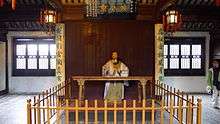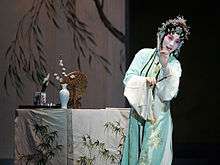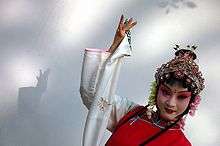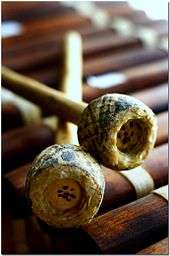Kunqu
| Kunqu | |||||||||||||||||||||||
| Traditional Chinese | 崑曲 | ||||||||||||||||||||||
|---|---|---|---|---|---|---|---|---|---|---|---|---|---|---|---|---|---|---|---|---|---|---|---|
| Simplified Chinese | 昆曲 | ||||||||||||||||||||||
| Literal meaning | "Kun[shan] Melody" | ||||||||||||||||||||||
| |||||||||||||||||||||||

Kunqu (Chinese: 崑曲), also known as Kunju (崑劇), Kun opera or Kunqu Opera, is one of the oldest extant forms of Chinese opera. It evolved from the Kunshan melody, and dominated Chinese theatre from the 16th to the 18th centuries. The style originated in the Wu cultural area. It is listed as one of the Masterpieces of the Oral and Intangible Heritage of Humanity by UNESCO since 2001.[1]
History




Kunqu singing techniques are said to have been developed during the Ming Dynasty by Wei Liangfu in the port of Taicang, but linked to the songs of nearby Kunshan.[2] Kunqu performance is closely inter-related with the performance of many other styles of Chinese musical theatre, including Jingju (Peking Opera), which contains much Kunqu repertoire. The emergence of chuanqi plays, commonly sung to Kunqu, is said to have ushered in a "second Golden Era of Chinese drama". Kunqu troupes experienced a commercial decline in the late 19th century. However, in the early 20th century, Kunqu was re-established by philanthropists as a theatrical genre that was subsequently subsidised by the Communist state. Like all traditional forms, Kunqu suffered setbacks both during the Cultural Revolution and again under the influx of Western culture during the Reform and Opening Up policies, only to experience an even greater revival in the new millennium. Today, Kunqu is performed professionally in seven Mainland Chinese major cities: Beijing (Northern Kunqu Theatre), Shanghai (Shanghai Kunqu Theatre), Suzhou (Suzhou Kunqu Theatre), Nanjing (Jiangsu Province Kunqu Theatre), Chenzhou (Hunan Kunqu Theatre), Yongjia County/Wenzhou (Yongjia Kunqu Theatre) and Hangzhou (Zhejiang Province Kunqu Theatre), as well as in Taipei. Non-professional opera societies are active in many other cities in China and abroad, and opera companies occasionally tour.
There are many plays that continue to be famous today, including The Peony Pavilion and The Peach Blossom Fan, which were originally written for the Kunqu stage. In addition, many classical Chinese novels and stories, such as Romance of the Three Kingdoms, Water Margin and Journey to the West were adapted very early into dramatic pieces.
Its melody or tune is one of the Four Great Characteristic Melodies in Chinese opera.
Repertoire
- The Peony Pavilion (Tang Xianzu)
- The Peach Blossom Fan (Kong Shangren)
- The Palace of Long Life (Hong Sheng)
- The White Snake
- The Western Mansion (Southern version, adapted from Wang Shifu's zaju)
- The Injustice done to Dou E (adapted from Guan Hanqing's zaju)
- The Kite (Li Yu)
Dramatists
- Tang Xianzu
- Kong Shangren
- Li Yu
- Hong Sheng
- Feng Menglong
Performers
- Yu Zhenfei
- Zhang Jiqing
- Wang Shiyu
- Yue Meiti
- Liang Guyin
- Cai Zhengren
- Ji Zhenhua
- Hua Wenyi
- Qian Yi
- Yan Huizhu
- Zhang Jun
References
- ↑ "Kun Qu Opera". UNESCO Cultural Sector - Intangible Heritage.
- ↑ according to Southern Lyrics Sung Correctly (南詞引正) by Wei Liangfu, a famous musician of the Ming Dynasty
External links
| Wikimedia Commons has media related to Kunqu. |
- UNESCO the Oral and Intangible Heritage of Humanity Kunqu Opera
- The Kunqu Society, Inc
- The Society of Kunqu Arts, Inc.
- What is Kunqu Theatre ?
